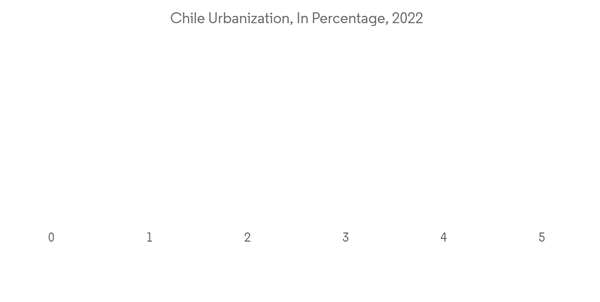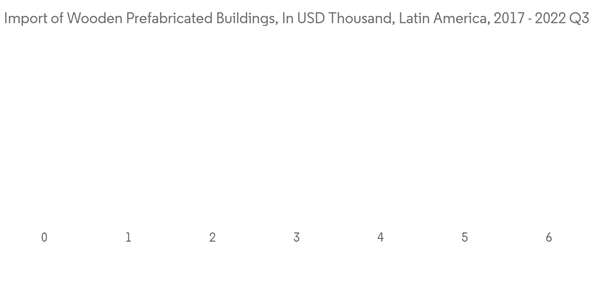Key Highlights
- Contractors and suppliers in South America's construction sector are experiencing extreme uncertainty as a result of the COVID-19 outbreak. Lockdowns and limitations forced some construction businesses to halt their projects.
- Before the industrial revolution, wood was the most important building material. During the last two centuries, however, wood has often been replaced by concrete, bricks, steel, and also plastics. However, these materials have a significant negative impact on the environment. To prevent this, more construction companies are considering using bio-based materials such as wood. Sustainable timber provides a more ecologically acceptable cladding material than manufactured panels, and the variations in hue provided by natural wood can provide a dynamic aesthetic to any green building. Governments are striving to use more bio-based building materials, including wood.
- The market for prefab wooden structures has an opportunity due to recent increases in the cost of traditional construction methods and the growth of green buildings in the region. In the first half of 2022, the costs of the construction industry in Brazil increased by 7.53%. In June 2022, there was an increase of 2.14% in the INCC, which corresponds to the third largest increase for that month in the last 28 years. According to the Mexican Chamber of the Construction Industry (CMIC), the cost of building materials, such as rebar, steel, and cement, increased 15% to 25% from December 2021 to April 2022. In addition to the building materials prices, the labor costs increased by 20% in Mexico.
- In February 2022, the U.S. Green Building Council (USGBC) announced Mexico ranks ninth in the world on its annual list of Top 10 Countries and Regions for LEED in 2021. Brazil is the other Latin American country to make the 2021 list and ranked number seven. Both countries represent the ever-growing international demand for certified LEED green buildings that help reduce environmental impact and support health and well-being.
Latin America Prefab Wood Buildings Market Trends
Increase of Urbanization in Chile Driving the Market
Chile has been one of Latin America’s fastest-growing economies in recent decades. Chile is experiencing growing urbanization. Some 90 percent of Chileans live in cities. Urbanization and the evolution of modern cities have led to the development of high-rise building constructions. Traditionally designed with concrete as the main structural material, their construction implies an increase in CO2 emissions released into the atmosphere, air pollution, and a rise in energy and water consumption. These consequences call for the development of new sustainable strategies outside of the industry’s comfort zone, such as the incorporation of wood as a structural element.During the last few years, the merging of timber building tradition with the application of new technologies has produced new prefabricated building systems. The current challenges in the present era in terms of sustainability have been addressed by architecture and construction. Aware of this need, Chile country has already been a tendency for some years to carry out projects that consider wood as the main material, as it is a renewable resource, low in emissions, and gradually allows the replacement of alternatives derived from natural resources.
Chile has shown sustained growth of buildings construction during the past decades but little further development in the use of wood. The Tamango Project by Tallwood architects is an example of the challenges and opportunities of wood construction in the country and the region, as it might potentially be the first 12-storey building with an engineered timber structure.
Demand of Prefabricated Buildings
Since 2020, the needs of new buyers have been evolving hand in hand with the real estate sector, before the decision to choose a home. To meet these new needs, modular homes have hit the market. Due to its benefits such as simplicity, ease of installation on any terrain, lower environmental impact, customization and costs up to 30% less compared to traditional houses, now they can be found on internet sites, more and more. Prefabricated houses in Mexico have gained popularity as they offer great advantages. Prefabricated wooden houses in Mexico are in fashion, due to their cheaper prices and speed of construction. Industrially prefabricated wood has come to stand out in recent years as one of the most used materials for housing construction.Prefabricated houses have gained prominence worldwide over the years. A triggering factor was the pandemic, as well as the increase in traditional housing costs of raw materials and the rise of minimalist trends. Currently, they are one of the main alternatives in conventional constructions and more and more people are choosing this type of modular housing.
It has been noted that there is room for more prefabricated homes to be built in order to meet the demand and supply for houses in the region. As Latin America’s biggest city, Sao Paulo has failed for decades to solve its severe housing crisis. More than 1.2 million people are in need of adequate housing. Currently, 1.2 million families have no place to call home. And with only 240,000 new housing units available each year, the housing shortage will be an ongoing issue in Colombia for years to come. Constructora Bolivar plans to introduce modular construction to the Colombian property owners and developers of multi-family buildings. The belief is that, as they become aware of the lower construction and maintenance costs, and the higher return on investment (ROI), modular construction will establish a foothold.
Latin America Prefab Wood Buildings Market Competitor Analysis
The major companies in the Latin America Prefab Wood Buildings industry are covered in this research. The market is fragmented, but it is likely to grow during the forecast period as prefab construction building investments and upcoming significant projects in various developing and developed countries increase. The major players include Green Magic Homes, VMD, Modulbox, E2E Chile, Techno Fast, Easywood, and All In Wall.Additional Benefits:
- The market estimate (ME) sheet in Excel format
- 3 months of analyst support
Table of Contents
Companies Mentioned (Partial List)
A selection of companies mentioned in this report includes, but is not limited to:
- Green Magic Homes
- VMD
- Modulbox
- E2E Chile
- Techno Fast
- Easywood
- All In Wall
- Pampa Corporation
- Casas Brazil
- Brasmerc
- BrasilCasas
- Dextra
- Impresa Modular
Methodology

LOADING...










